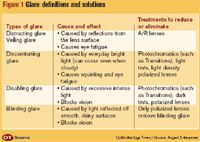Article
Future's so bright, you gotta wear shades
Sunwear-both plano and prescription-has the greatest profit potential in a professional ophthalmic dispensary.

Last year, the overall ophthalmic product market was basically flat. The only growth area was in high-quality designer eyewear and sunwear. Data show that in the ophthalmic industry during 2006, only high-quality frames priced at more than $150 showed growth. Designer sunwear, both plano and prescription, had tremendous growth in the optical dispensary market. The average plano designer sunwear retails for approximately $250.

After all, good eye health depends on, as Transitions Optical puts it, "healthy sight in every light." Every patient should have at least two pairs of glasses: primary eyewear and sunwear, whether plano or prescription.

Sunwear-eye health relationship
Throughout the entire span of a patient's visit to your practice, the concepts of sunwear and primary eyewear must be discussed, demonstrated, and reinforced. The discussion begins in the examination room and should continue through the eye exam process with your ophthalmic assistants and in the dispensary with the opticians.
Frankly, sunwear should be addressed as part of every ophthalmologist's prescription analysis discussion with each patient. Prescription analysis is the art and science of communicating the features and benefits of products to meet the visual needs of the patient.
Francis A. D'Ambrosio Jr., MD, medical director, D'Ambrosio Eye Care, Boston, said he makes explaining the need for sunwear a must during eye exams.
"In the examination room, we recommend to our patients quality sunwear for the protection and health of the eye," he said. "We consider polarized lenses 'safety driving lenses.' Everyone who drives a vehicle should use sunwear with quality plano or prescription polarized lenses. All children should have safe, quality sunwear made of polycarbonate or Trivex to help prevent UV radiation exposure."
Newsletter
Don’t miss out—get Ophthalmology Times updates on the latest clinical advancements and expert interviews, straight to your inbox.




